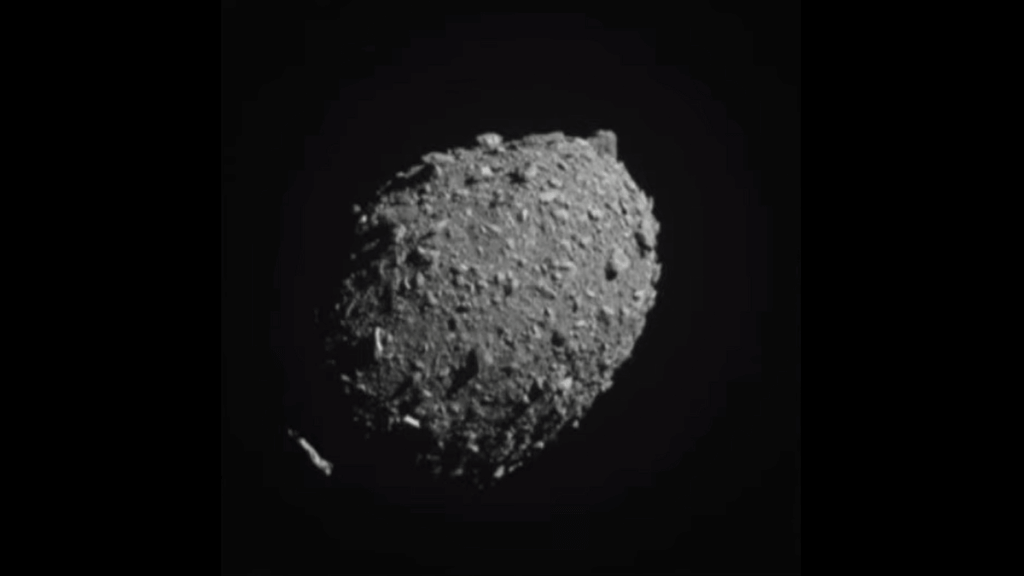Rogue asteroids, to put it simply, pose a threat to Earth. Though there hasn’t been a cataclysmic event in about 65 million years, that’s not to say there haven’t been nail-biting moments during space rock flybys — in 2013, for instance, the Chelyabinsk asteroid slammed into Earth’s atmosphere “blazing like a second sun” and sending shockwaves through the surrounding area.
Space agencies around the world understandably want to be prepared. To this end, NASA launched the Double Asteroid Redirection Test (DART) spacecraft in 2022, its first mission dedicated to demonstrating asteroid deflection through kinetic impact. DART successfully collided with a near-Earth asteroid called Dimorphos, which is part of a binary system as it orbits a larger asteroid named Didymos. Lots of incredible information has been gleaned from this impact already, and we just got a little more. According to a paper published this year about the event, DART created a large crater in Dimorphos, in fact reshaping the rock so dramatically it derailed from its original progression.
“For the most part, our original pre-impact predictions about how DART would change the way Didymos and its moon move in space were correct,” Derek Richardson, a professor of astronomy at the University of Maryland and a DART investigation working group lead, said in a statement. “But there are some unexpected findings that help provide a better picture of how asteroids and other small bodies form and evolve over time.”
One surprise was just how much DART was able to alter Dimorphos. Prior to the collision, the asteroid was oblate, meaning it was somewhat flattened or squished along one axis, likely due to its own rotation or gravitational effects.
Related: NASA radar images show stadium-size asteroid tumbling by Earth during flyby
After the collision, Dimorphos’ shape became prolate, meaning the asteroid was stretched along its axis, making it longer in one direction. The impact likely caused this elongation by redistributing the asteroid’s mass and altering its rotational dynamics.
“We were expecting Dimorphos to be prolate pre-impact simply because that’s generally how we believed the central body of a moon would gradually accumulate material that’s been shed off a primary body like Didymos. It would naturally tend to form an elongated body that would always point its long axis toward the main body,” Richardson explained. “But this result contradicts that idea and indicates that something more complex is at work here. Furthermore, the impact-induced change in Dimorphos’ shape likely changed how it interacts with Didymos.”
The DART collision has indeed affected the dynamics and equilibrium of both parts of the targeted binary system, shortening Dimorphos’ orbit overall, just as scientists had hoped.
“Originally, Dimorphos was probably in a very relaxed state and had one side pointing toward the main body, Didymos, just like how Earth’s moon always has one face pointing toward our planet,” Richardson explained. “Now, it’s knocked out of alignment, which means it may wobble back and forth in its orientation. Dimorphos might also be ‘tumbling,’ meaning that we may have caused it to rotate chaotically and unpredictably.”
Scientists also observed that Didymos’ shape remained unchanged, suggesting that the larger asteroid is structurally stable and resilient enough to retain its form.
The team is now waiting to find out when the ejected debris will clear from the system, whether Dimorphos is still tumbling in space and when (or if) the object will eventually regain its previous stability.
“One of our biggest questions now is if Dimorphos is stable enough for spacecraft to land and install more research equipment on it,” he said. “It could take a hundred years to see noticeable changes in the system, but it’s only been a few years since the impact. Learning about how long it takes Dimorphos to regain its stability tells us important things about its internal structure, which in turn informs future attempts to deflect hazardous asteroids.”
These findings will have important implications for future missions, including the European Space Agency’s follow-up flight to the Didymos system in October 2024.
“DART gave us insight into complicated gravitational physics that you can’t do in a lab, and all of this research helps us calibrate our efforts to defend Earth in the event of an actual threat,” Richardson said. “There’s a nonzero chance that an asteroid or comet will approach and endanger the planet. Now, we have an additional line of defense against these kinds of external threats.”
The paper was published on Aug. 23 in The Planetary Science Journal.

